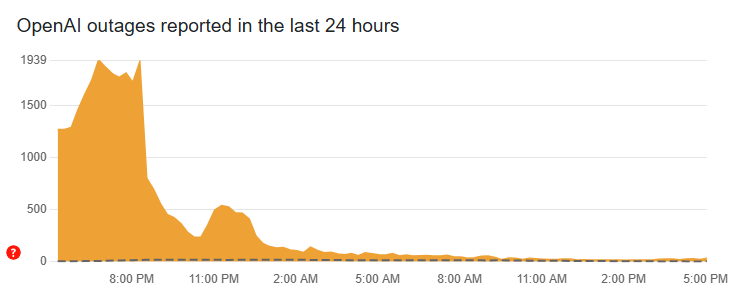On June 10, 2025, millions of users worldwide experienced something they didn’t expect – ChatGPT just stopped working. For more than 10 hours, one of the world’s most popular AI chatbots had little to no functionality. ChatGPT being offline meant that many users were frustrated, and also emphasized just how much we have come to rely on artificial intelligence (AI) in our daily lives.
Table of Contents
What Exactly Happened During the Outage?
Issues began in the early hours of June 10, 2025, around 2:45 AM Eastern Time, when users began reporting issues, at which point Down Detector, an outage monitoring website, began showing increased reports of issues.
The issue wasn’t only with the core ChatGPT service. Both free and paid users were affected, and OpenAI’s image generator Sora was also experiencing major issues. Some users received error messages that read “Too many concurrent requests” while others reported not being able to get ChatGPT to load at all.
How Many People Were Affected?
The size of the outage was enormous. Down Detector had nearly 2,000 outage reports at the peak, but this may have mostly been a fraction, as many users do not report their problems to outage-tracking websites. Users in the United Kingdom, Europe, North America, and Australia reported issues as they came online throughout the day.

The Timeline of Events
Early Morning (2:45 AM ET)
- The first reports showed up on Down Detector
- Users began to see “Too many concurrent requests” errors
- Some users saw ChatGPT completely broken
Throughout the Day
- OpenAI early on acknowledged they were having issues, but said very little
- The status page indicated “elevated error rates” for over seven hours
- There were issues throughout the day as OpenAI tried to fix the problem
Resolution (Over 10 hours after the first reports)
- OpenAI stated that they were able to identify the issue
- At 3:24 PM EDT, OpenAI stated the API was fully recovered
- Most users were able to return to normal service through the REST of the afternoon and into the evening.
Why OpenAI’s Response Was Limited
One of the most frustrating aspects of the outage has been OpenAI’s failure to provide detailed explanations as to what went wrong. The company confirmed that the company was aware of the issue but did not give much detail about what caused it or when it would be fixed.
Either way, it left a lot of users unsure of the situation, especially those who use ChatGPT for work or important projects. Transparency was even more important since this outage was much worse than the site’s previous blackout in March 2025.
The Real Impact on Users
For Students and Professionals
Many users were in a very tough position given the timing of the outage. Students that were preparing for exams no longer had their AI study buddy, while professionals that had made ChatGPT part of their daily routine were hurriedly debating which applications were available to replace ChatGPT.
Business Disruption
Companies that have incorporated ChatGPT into their business models did it in a way that is suddenly unavailable to them. Customer service teams, content development teams, and programmers all experienced their world spinning out of control when their AI device was pulled out from underneath then.
The Emotional Reaction
Many users described feeling “stuck” and “lost” when not having access to ChatGPT. This reaction emphasizes something significant and worthy of consideration – how quickly humans adapt to new technology and how habitual it can become.
What Alternatives Did People Use?
When ChatGPT was down for a period of time (over 10 hours), millions of users did not sit around and wait. They found alternative ways to get work done. Here’s where people went in the lengthy downtime:
Claude
- Many new users have tried Claude out for the first time
- Easy to write with and answer questions
- Became the top replacement choice
Google Gemini
- People loved it was free and simple with a Gmail account
- Astoundingly useful for research and current information
- Had a huge uptick in new users
Microsoft Copilot
- Built into Windows and Edge
- Helped with emails and documents
- Free with a Microsoft account
DeepSeek
- Chinese AI platform that surprised many users
- Fast and reliable in the midst of the crisis
- Many people kept using it even when ChatGPT came back
How OpenAI Handled the Crisis
Initial Response
OpenAI recognized the trouble fairly quickly, but shared very little detail about the reason for it, or how quickly they would be able to recover.
Recovery Work
The company responded throughout the day to restore functionality, indicating on their status page they were working on resolving “elevated error rates.”
Final Outcome
After over 10 hours, OpenAI indicated full recovery, yet some users still faced intermittent issues even for hours afterward.
Final Thoughts
The June 10, 2025, ChatGPT outage revealed an important lesson about technology and AI. The experience was a reminder that, even with advanced technology, it can still crash.
The takeaway here shouldn’t be to stop using AI tools at all; instead, it’s important to find a balance. AI can augment your work, but it’s useful to have skills and methods available if the tech stops working.
As AI evolves and becomes more complex, outages like these will become opportunities to learn, grow, and understand the tools better, while eventually making those tools more robust and fault resilient. The key is to be flexible and adaptable with all the tools at your disposal. It’s also important to consider that underneath the AI there are creativity and problem solving – which sets humans apart from machines.
What other AI collaborative tools do you use when your service goes down? When it comes to a backup plan, it’s not just wise – it is absolutely critical in the time of AI tools.
